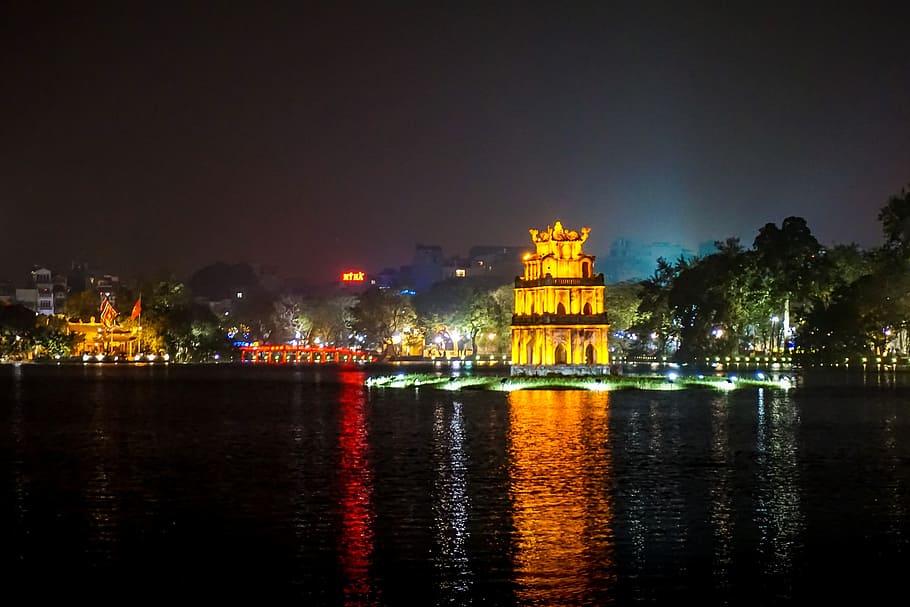Hey there, fellow traveller! Get ready to dive into the extraordinary side of Hanoi’s tourist attractions. We’re about to uncover some seriously cool stuff that’ll make your jaw drop and leave you with memories to brag about. So buckle up and let’s get this adventure started!
Hanoi, this buzzing city of history and culture, has more surprises up its sleeve than you’d expect. Sure, you’ve got famous spots like the Temple of Literature and Ho Chi Minh Mausoleum, but we’re about to take you off the beaten path to discover the hidden gems that’ll make your trip truly unforgettable.
Imagine crossing the legendary Long Bien Bridge, an architectural masterpiece that’s been standing tall for ages. It’s like stepping into a time machine! And speaking of time travel, get lost in the enchanting alleyways of the French Quarter. You’ll find charming old buildings and cosy cafes that’ll transport you back to a bygone era.
Exciting, right? Get ready to discover the best tourist attractions in Hanoi, from the must-see landmarks to the hidden treasures that’ll blow your mind. Let’s dive into this ultimate guide and make some unforgettable memories!
Top 40 Tourist Attractions in Hanoi
Must-See Tourists Attractions
Hoan Kiem Lake: Hoan Kiem Lake, also known as the Lake of the Restored Sword, is a serene oasis in the heart of Hanoi. Legend has it that a magical sword was returned to a giant turtle here, cementing its significance in Vietnamese folklore. Surrounded by beautiful greenery, the lake offers a peaceful escape from the bustling city. You can take a leisurely stroll, visit the Ngoc Son Temple on the lake’s small island, search for beautiful lacquer paintings or simply relax and enjoy the scenic views.
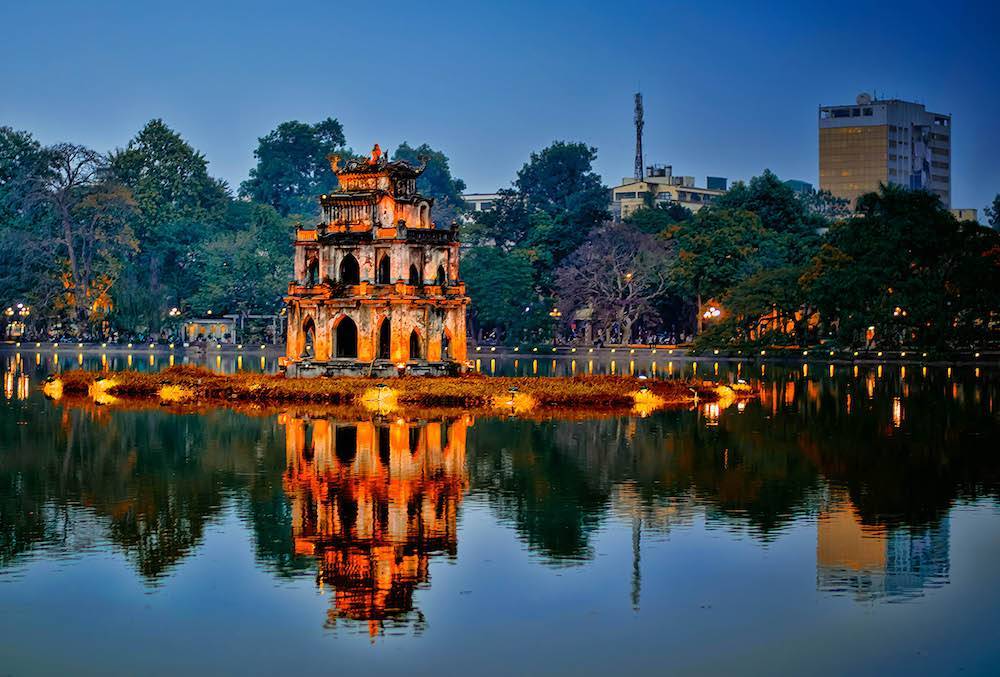
The Old Quarter: Hanoi’s Old Quarter is a vibrant and bustling neighbourhood that dates back to the 13th century. It is known for its narrow streets, historic buildings, and traditional architecture. Walking through the maze-like streets, you’ll find a wide array of shops, street food vendors, and traditional markets selling everything from silk products to local handicrafts. The Old Quarter is a sensory delight, offering a glimpse into the rich cultural heritage of Hanoi. Check out all the activities we recommend trying while you wander across the Old Quarter.
Ho Chi Minh Mausoleum: The Ho Chi Minh Mausoleum is a monumental Ba Dinh Square structure dedicated to the revered Vietnamese leader, Ho Chi Minh. As you approach the mausoleum, you’ll be awed by its imposing architecture and grandeur. Inside, the embalmed body of Ho Chi Minh lies in the state, allowing visitors to pay their respects to the iconic figure of Vietnam’s struggle for independence. The mausoleum is surrounded by beautifully landscaped gardens, making it a peaceful and reflective place to visit.
Temple of Literature: The Temple of Literature, also known as Van Mieu, is a Confucian temple that served as Vietnam’s first national university. Built in 1070, it is a well-preserved example of traditional Vietnamese architecture. The temple complex is dedicated to Confucius and honours scholars and intellectuals. As you explore its courtyards, pavilions, and gardens, you’ll gain insight into Vietnam’s ancient educational system. The Temple of Literature is a serene and culturally significant site, offering a fascinating glimpse into Vietnam’s past.
Thang Long Water Puppet Theatre: The Thang Long Water Puppet Theatre is a unique cultural attraction in Hanoi. Dating back to the 11th century, water puppetry is a traditional form of Vietnamese entertainment. The performances take place on a stage of water, with intricately crafted wooden puppets brought to life by skilled puppeteers. The shows depict folk tales, legends, and scenes from rural Vietnamese life. The combination of live music, colourful puppets, and water effects creates a mesmerizing and enchanting experience for visitors of all ages. Attending a water puppet show at Thang Long Water Puppet Theatre is a must-do when in Hanoi.
St. Joseph’s Cathedral: St. Joseph’s Cathedral, located in the heart of Hanoi, is a striking example of French colonial architecture. Built-in the late 19th century, the cathedral features neo-Gothic design elements and impressive stained glass windows. As you step inside, you’ll be greeted by a serene and atmospheric space, filled with religious icons and intricate details. St. Joseph’s Cathedral is a place of worship and a famous landmark and meeting point for locals and visitors alike.
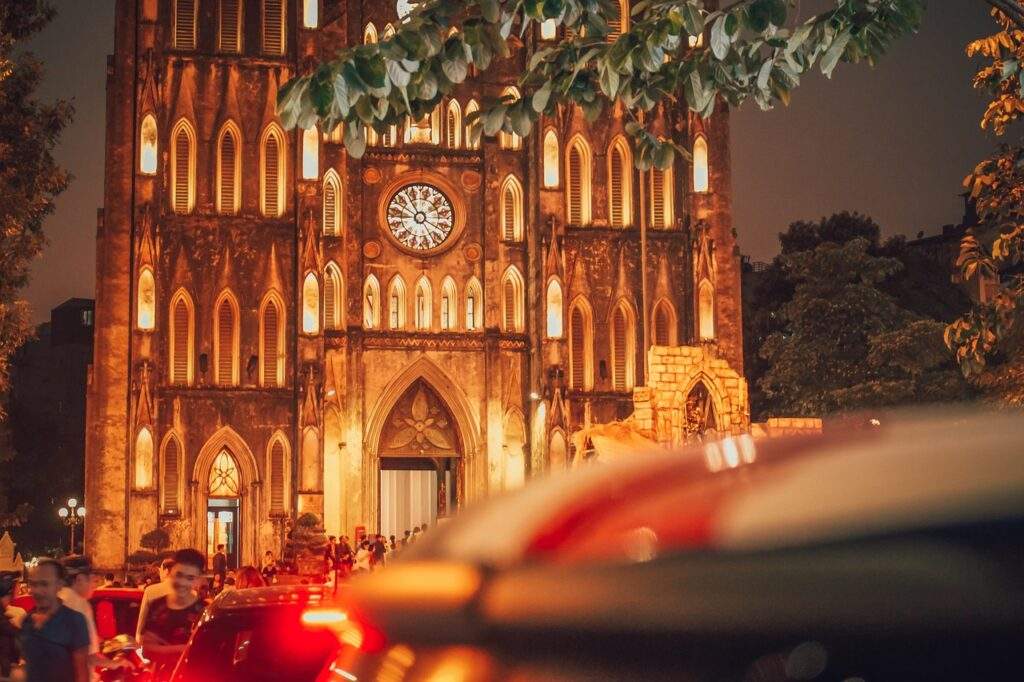
Dong Xuan Market: Dong Xuan Market is the largest covered market in Hanoi and a vibrant hub of activity. Located in the Old Quarter, it offers a vast array of goods, from fresh produce and spices to clothing, electronics, and souvenirs. The market is a feast for the senses, with colourful displays, bustling crowds, and the enticing aromas of street food. Exploring Dong Xuan Market is a great way to immerse yourself in the local culture and experience the vibrant atmosphere of Hanoi.
Hoa Lo Prison Museum: Hoa Lo Prison Museum, also known as the “Hanoi Hilton,” is a historic site that provides a sobering glimpse into Vietnam’s past. Originally built by the French colonialists in the late 19th century, the prison was later used to house American prisoners of war during the Vietnam War. The museum exhibits tell the stories of the prisoners and provide insight into the conditions they endured. Walking through the preserved cells and viewing the artefacts and photographs offers a stark reminder of the hardships faced by those held captive here.
Vietnam Museum of Ethnology: The Vietnam Museum of Ethnology is a fascinating institution that showcases the rich cultural diversity of Vietnam’s ethnic groups. The museum’s extensive collection includes traditional artefacts, clothing, tools, and art from various ethnic communities nationwide. Through its exhibits, interactive displays, and traditional houses, the museum offers a comprehensive insight into the customs, traditions, and ways of life of Vietnam’s diverse ethnic groups. It provides a valuable opportunity to learn about and appreciate the cultural heritage and traditions that make up the fabric of Vietnam.
West Lake: West Lake, also known as Ho Tay, is the largest lake in Hanoi and a popular recreational area. Surrounded by lush greenery and dotted with pagodas, it offers a tranquil escape from the urban hustle and bustle. You can take a leisurely walk or bike ride along the lake’s perimeter, enjoy a boat ride, or simply relax at one of the lakeside cafes. West Lake is particularly picturesque during sunset, offering stunning views and a serene ambience.
Tran Quoc Pagoda: Tran Quoc Pagoda is one of Vietnam’s oldest Buddhist pagodas and a significant religious site in Hanoi. Located on a small island in West Lake, it offers a peaceful and spiritual retreat. The pagoda is known for its elegant architecture, beautiful statues, and serene surroundings. As you explore the pagoda grounds, you’ll find a sense of tranquillity and reverence. Tran Quoc Pagoda is a must-visit for those seeking a deeper understanding of Vietnam’s Buddhist heritage.
Hanoi Opera House: The Hanoi Opera House is an architectural masterpiece that showcases the grandeur of French colonial design. Built-in the early 20th century, it has been meticulously restored and remains a prominent venue for cultural performances. The opera house hosts a variety of shows, including ballet, classical music concerts, and traditional Vietnamese opera. Even if you don’t attend a performance, admiring the exterior façade and capturing photos of this iconic building is well worth a visit.
Hanoi Ancient Citadel: The Hanoi Ancient Citadel, also known as the Imperial Citadel of Thang Long, is a UNESCO World Heritage site and a testament to Vietnam’s rich historical legacy. Dating back over a thousand years, the citadel served as the political and cultural centre of the country for many centuries. Exploring the ancient citadel grounds allows you to discover the remnants of palaces, gates, and ancient architectural structures. The site also houses a museum that exhibits artefacts and relics from various periods of Vietnamese history.
Long Bien Bridge: Long Bien Bridge is an iconic symbol of Hanoi, spanning the Red River and connecting the city’s historic centre with the eastern suburbs. Built over a century ago, it is an engineering marvel and a survivor of wars and conflicts. Walking or cycling across the bridge offers panoramic views of the river and the cityscape. Long Bien Bridge is not only a transport route but also a historical landmark that tells the story of Hanoi’s resilience and endurance.
Unique Things to do in Hanoi
Bat Trang Ceramic Village: Bat Trang Ceramic Village is located on the banks of the Red River, just outside Hanoi. Renowned for its centuries-old tradition of pottery making, the village is a haven for ceramic enthusiasts and art lovers. You can explore the narrow streets lined with workshops, observe artisans at work, and even try your hand at creating your own ceramic masterpiece. The village’s pottery products, ranging from intricately designed vases to delicate tea sets, make for unique souvenirs or decorative items to bring back home.
Vietnamese Women’s Museum: The Vietnamese Women’s Museum is a unique institution that celebrates the contributions and achievements of Vietnamese women throughout history. Through its exhibits, the museum explores various aspects of women’s lives, including family, fashion, work, and the role of women in the country’s development. The displays are thoughtfully curated, combining artefacts, photographs, and multimedia presentations to provide an engaging and enlightening experience.
Quan Thanh Temple: Quan Thanh Temple is a Taoist temple located near West Lake. Built during the 11th century, it is dedicated to Tran Vu, the God of the North. The temple’s architecture is an impressive blend of Vietnamese and Chinese styles, featuring intricate wood carvings and beautiful statues. Walking through the temple’s courtyards and admiring its serene ambience allows for a moment of reflection and appreciation of Vietnam’s spiritual heritage.
National Museum of Vietnamese History: The National Museum of Vietnamese History is a comprehensive museum that chronicles the history of Vietnam from ancient times to the present day. The museum’s exhibits cover various periods, including prehistoric times, the Dong Son culture, the Cham kingdom, and the Vietnamese struggle for independence. Through its extensive collection of artefacts, sculptures, and historical relics, the museum offers a deep insight into Vietnam’s rich and diverse cultural heritage.
Fine Arts Museum: The Fine Arts Museum in Hanoi is a treasure trove of Vietnamese art, showcasing a wide range of works from different periods and artistic styles. The museum’s collection includes traditional folk art, contemporary paintings, sculptures, and lacquerware. Exploring the museum’s galleries allows you to appreciate the evolution of Vietnamese art and gain a deeper understanding of its cultural significance.
Perfume Pagoda: The Perfume Pagoda, also known as Huong Pagoda, is a complex of Buddhist temples and shrines located in a scenic limestone landscape, approximately 60 kilometers southwest of Hanoi. The pagoda is nestled amidst stunning natural beauty, accessible by a boat ride along the Yen River followed by a hike or cable car ride up to the main temple complex. The Perfume Pagoda is a popular pilgrimage site, particularly during the annual Perfume Pagoda Festival. Visiting the pagoda offers a spiritual journey and an opportunity to appreciate the natural splendour of the surrounding area.
Hanoi Botanical Garden: Hanoi Botanical Garden is a peaceful oasis in the city’s heart. Established in 1890, this lush green space offers a welcome respite from the urban hustle and bustle. Strolling through the garden’s well-manicured paths, you’ll encounter a wide variety of plant species, including rare and exotic plants. The garden also houses a small zoo, making it a great place for a leisurely family outing or a tranquil escape into nature.
National Museum of Vietnamese Revolution: Located in the former French governor’s palace, the National Museum of Vietnamese Revolution offers a comprehensive overview of Vietnam’s struggle for independence and its revolutionary history. Through its exhibits, photographs, and artefacts, the museum tells the story of Vietnam’s fight against colonialism, imperialism, and its path towards independence. It is a place of reflection and an opportunity to gain a deeper understanding of Vietnam’s past.
Truc Bach Lake: Truc Bach Lake is a picturesque freshwater lake located in the heart of Hanoi. It is known for its peaceful ambience and scenic views. The lake is surrounded by charming cafes and restaurants, making it a popular spot for locals and visitors to relax and enjoy the tranquil surroundings. Truc Bach Lake is particularly famous for its delicious “pho cuon,” a local dish consisting of fresh rice noodles rolled with beef or vegetables. Exploring the lake’s perimeter and sampling this local delicacy is a delightful experience.
Tay Ho Temple: Tay Ho Temple, also known as the Temple of the West Lake, is a beautiful and historic temple located on a peninsula on West Lake. Dating back over a thousand years, the temple is dedicated to the Goddess of Water. As you approach the temple, you’ll be captivated by its ornate architecture and tranquil setting. Inside, you’ll find intricate wood carvings, colourful pagodas, and beautiful statues. The temple’s serene atmosphere and panoramic views of the lake make it a popular destination for locals and tourists alike.
Vietnam National Museum of Fine Arts: The Vietnam National Museum of Fine Arts is a treasure trove of Vietnamese art, spanning from ancient times to the contemporary era. The museum’s extensive collection includes paintings, sculptures, ceramics, and lacquerware. As you explore the museum’s galleries, you’ll gain insight into the evolution of Vietnamese art and its cultural significance. The museum showcases both traditional and modern artistic styles, offering a comprehensive overview of Vietnam’s vibrant art scene.
One Pillar Pagoda: The One Pillar Pagoda is an iconic Buddhist temple and a symbol of Hanoi. Built-in the 11th century, the pagoda stands on a single stone pillar emerging from a lotus pond. Its unique architecture, resembling a blooming lotus, is a sight to behold. The pagoda is considered an important spiritual and cultural site, attracting visitors from all over the world. A visit to the One Pillar Pagoda allows you to admire its architectural beauty and experience the serenity of a sacred Buddhist place.
Thanh Chuong Viet Palace: Thanh Chuong Viet Palace is a unique cultural complex that showcases the artistic and architectural talents of Thanh Chuong, a renowned Vietnamese artist. The palace is a fusion of traditional Vietnamese architecture and contemporary artistic expression. As you wander through its gardens, courtyards, and buildings, you’ll encounter a multitude of sculptures, paintings, and installations. The palace offers a glimpse into the artist’s creative vision and his passion for preserving Vietnamese cultural heritage.
Hanoi Ceramic Mosaic Mural: The Hanoi Ceramic Mosaic Mural is a remarkable public art installation that stretches for over 6 kilometres. It holds the Guinness World Record for being the longest ceramic mosaic in the world. The mural depicts scenes from Vietnamese history, culture, and daily life, created from thousands of colourful ceramic tiles. Walking along the mural allows you to appreciate the talent and creativity of the artists involved and provides a unique perspective on Hanoi’s rich cultural heritage.
Thanh Nien Street: Thanh Nien Street is a picturesque tree-lined boulevard that runs along the eastern shore of West Lake. It offers stunning views of the lake and the iconic Tran Quoc Pagoda. The street is particularly popular for its vibrant flower gardens, especially during the cherry blossom season when the trees come alive with delicate pink blooms. Thanh Nien Street is a great place for a leisurely walk or bike ride, allowing you to soak in the beauty of the surroundings.
B52 Victory Museum: The B52 Victory Museum is a testament to Vietnam’s resilience and victory during the Vietnam War. The museum is dedicated to the downing of a US B-52 bomber during the Christmas Bombings in 1972. It showcases the wreckage of the bomber, along with photographs, artefacts, and personal accounts of the event. Exploring the museum provides an opportunity to reflect on the devastating impacts of war and the indomitable spirit of the Vietnamese people.
Quan Su Pagoda: Quan Su Pagoda is a significant Buddhist temple and the headquarters of the Vietnam Buddhist Sangha. Situated in the heart of Hanoi, the pagoda is known for its tranquil ambience and beautiful architecture. The temple’s interiors are adorned with intricate wood carvings, delicate statues, and colourful murals. Quan Su Pagoda serves as a place of worship and a centre for Buddhist teachings and activities.
Imperial Citadel of Thang Long: The Imperial Citadel of Thang Long is a UNESCO World Heritage site and a testament to Vietnam’s rich historical legacy. Built over a millennium ago, the citadel served as the political and cultural centre of the country for many centuries. Exploring the citadel’s archaeological site allows you to discover the remnants of palaces, ancient structures, and historical artefacts. The site also houses a museum that exhibits relics and provides insights into the citadel’s significance in Vietnamese history.
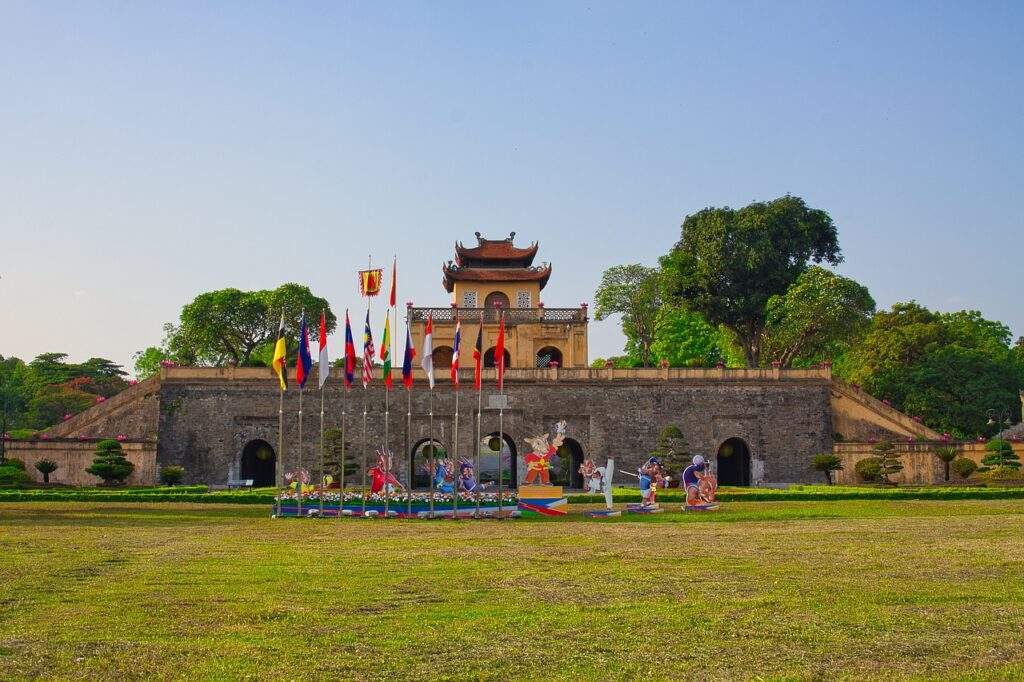
Vietnamese National Tuong Theatre: The Vietnamese National Tuong Theatre is a cultural institution dedicated to preserving and promoting the traditional art form of Tuong, also known as Vietnamese classical opera. Tuong combines music, dance, and acting elements, depicting historical and mythical stories. Attending a Tuong performance at the theatre offers a glimpse into Vietnam’s rich performing arts heritage and provides a unique entertainment experience.
Hanoi Railway Station: Hanoi Railway Station is a historic landmark and a gateway to exploring other parts of Vietnam by train. Built during the French colonial era, the station showcases a blend of French and Vietnamese architectural styles. Witnessing the hustle and bustle of the station, with trains departing and arriving, provides a glimpse into the daily lives of the Vietnamese people and the importance of rail travel in the country.
Ba Vi National Park: Ba Vi National Park is a nature lover’s paradise located just outside of Hanoi. This sprawling park is known for its lush forests, scenic landscapes, and diverse wildlife. It offers a range of outdoor activities, including hiking trails, camping sites, and bird-watching opportunities. The park is also home to Ba Vi Mountain, which offers panoramic views of the surrounding countryside. Whether you’re seeking a peaceful retreat or an adventurous getaway, Ba Vi National Park is a perfect destination to immerse yourself in the beauty of nature.
Quan Thanh Temple: Quan Thanh Temple is a Taoist temple near West Lake. Built during the 11th century, it is dedicated to Tran Vu, the God of the North. The temple’s architecture is an impressive blend of Vietnamese and Chinese styles, featuring intricate wood carvings and beautiful statues. Walking through the temple’s courtyards and admiring its serene ambience allows for a moment of reflection and appreciation of Vietnam’s spiritual heritage.
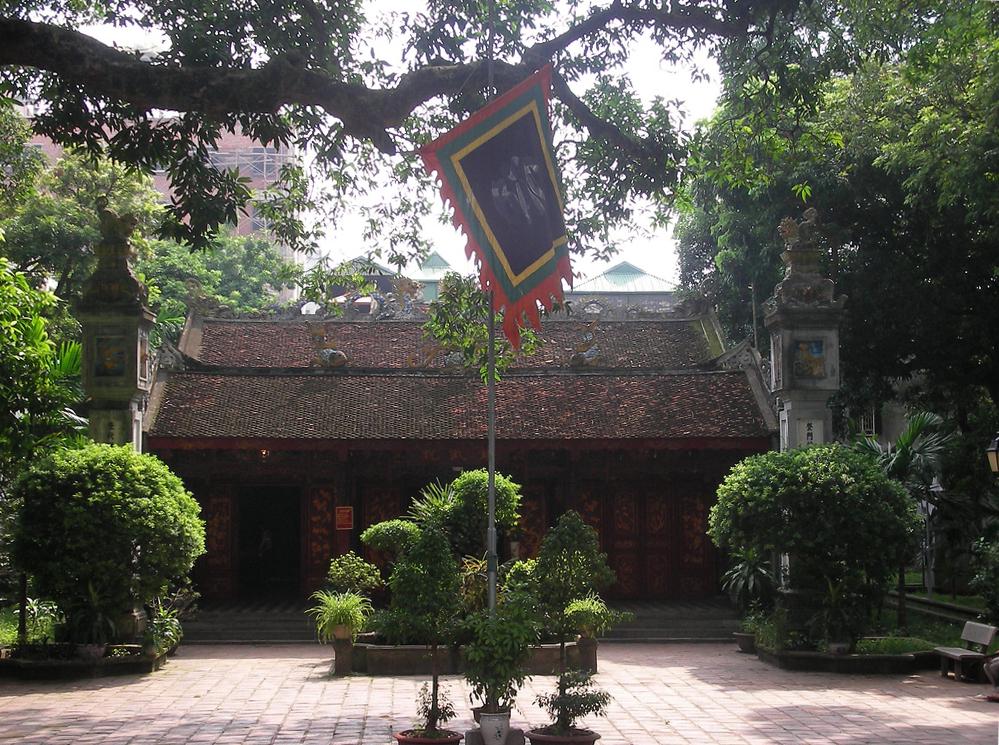
National Museum of Vietnamese History: The National Museum of Vietnamese History is a comprehensive museum that chronicles the history of Vietnam from ancient times to the present day. The museum’s exhibits cover various periods, including prehistoric times, the Dong Son culture, the Cham kingdom, and the Vietnamese struggle for independence. The museum offers a deep insight into Vietnam’s rich and diverse cultural heritage through its extensive collection of artefacts, sculptures, and historical relics.
Fine Arts Museum: The Fine Arts Museum in Hanoi is a treasure trove of Vietnamese art, showcasing a wide range of works from different periods and artistic styles. The museum’s collection includes traditional folk art, contemporary paintings, sculptures, and lacquerware. Exploring the museum’s galleries allows you to appreciate the evolution of Vietnamese art and gain a deeper understanding of its cultural significance.
Perfume Pagoda: The Perfume Pagoda, also known as Huong Pagoda, is a complex of Buddhist temples and shrines located in a scenic limestone landscape, approximately 60 kilometers southwest of Hanoi. The pagoda is nestled amidst stunning natural beauty, accessible by a boat ride along the Yen River followed by a hike or cable car ride
Hanoi Ceramic Village: Hanoi Ceramic Village, also known as Bat Trang Ceramic Village, is a traditional craft village located on the outskirts of Hanoi. This village has been renowned for its ceramic production for centuries. Visitors to the village can explore the workshops and witness the artisans at work, shaping clay, painting intricate designs, and firing the ceramics in kilns. The village offers a wide range of ceramic products, including bowls, vases, plates, and figurines, which make for great souvenirs or unique gifts. In addition to shopping, visitors can also try their hand at making their own pottery under the guidance of skilled artisans. A visit to Hanoi Ceramic Village provides a fascinating glimpse into the rich heritage of Vietnamese ceramics and the craftsmanship that goes into creating these beautiful pieces.
Out-of-the-box tourist attractions in Hanoi
Ready to explore Hanoi in a whole new way? Get ready for a list of out-of-the-box tourist attractions in Hanoi that will take your experience to the next level. Beyond the well-known landmarks, we’ve curated a selection of unique and offbeat experiences that will leave you with unforgettable memories. From immersive workshops to thrilling adventures, get ready to discover the hidden gems and extraordinary attractions that make Hanoi truly special. So, buckle up and let’s dive into this list of out-of-the-box tourist attractions that will add a touch of excitement and wonder to your Hanoi itinerary.
- Water Puppetry Workshop: Instead of just watching a water puppetry show, why not participate in a water puppetry workshop? Several places in Hanoi offer hands-on experiences where you can learn the art of controlling traditional water puppets. Under the guidance of skilled puppeteers, you’ll get to manipulate the puppets, learn the techniques, and even create your own short puppet performance. It’s a unique opportunity to delve into Vietnamese folk art and gain a deeper appreciation for this traditional form of entertainment.
- Street Food Tour by Vintage Vespa: While exploring Hanoi’s street food scene is a must-do, you can take it to the next level by embarking on a street food tour on a vintage Vespa scooter. Join a guided tour that takes you through the bustling streets of Hanoi, stopping at local street food stalls and hidden eateries known only to the locals. Riding pillion on the back of a vintage Vespa, you’ll savour delicious street food dishes while zipping through the city, immersing yourself in the vibrant energy of Hanoi’s food culture.
- Hidden Coffee Shops Exploration: Hanoi is famous for its coffee culture, but instead of sticking to the popular coffee shops, venture off the beaten path to discover hidden coffee gems. Explore the narrow alleyways of the Old Quarter or the quieter neighbourhoods to find quaint cafes tucked away in unexpected places. These hidden coffee shops often have unique atmospheres, whether they’re hidden in old colonial buildings, hidden courtyards, or rooftop terraces with stunning views. It’s a chance to escape the crowds, enjoy a cup of Vietnamese coffee, and soak in the charm of Hanoi’s hidden corners.
- Vietnamese Cooking Class: Immerse yourself in the flavours of Vietnamese cuisine by taking a cooking class. Join a local cooking school or a home-based cooking experience where you’ll learn how to prepare traditional Vietnamese dishes. From shopping for ingredients at local markets to mastering the art of creating dishes like pho or fresh spring rolls, a cooking class allows you to not only taste the flavours of Vietnam but also learn the techniques to recreate these dishes back home.
- Hanoi Street Art Exploration: Beyond its historical landmarks, Hanoi has a vibrant street art scene waiting to be discovered. Take a self-guided tour or join a street art tour to explore the city’s colourful murals, graffiti, and artistic installations. From hidden alleyways in the Old Quarter to large-scale murals in the newer parts of the city, you’ll find thought-provoking artwork that reflects Vietnam’s social, cultural, and political themes.
- Motorbike Adventure to Rural Villages: Escape the city for a day and embark on a motorbike adventure to explore the rural villages surrounding Hanoi. Rent a motorbike or join a guided tour, and ride through picturesque countryside landscapes, passing by rice fields, traditional villages, and scenic roads. You’ll have the opportunity to interact with locals, learn about their way of life, and witness traditional crafts being practised, such as pottery-making or weaving. It’s a chance to experience the authentic rural side of Vietnam and get off the typical tourist trail.
- Hanoi Escape Rooms: Put your problem-solving skills to the test by trying out the popular trend of escape rooms in Hanoi. Gather a group of friends and choose from various themed escape rooms, where you’ll be locked in a room and have to solve puzzles, find hidden clues, and work together to escape within a set time limit. It’s a fun and challenging activity that will test your teamwork and critical thinking abilities while providing an adrenaline-filled experience.
- Vietnamese Traditional Music Performance: Experience the enchanting sounds of Vietnamese traditional music by attending a live performance. Look for venues that offer traditional music shows, such as the Hanoi Opera House or small cultural centres. You’ll be treated to mesmerizing performances of instruments like the dan bau (monochord), the dan tranh (16-string zither), or the bamboo flute. The music, combined with traditional costumes and graceful movements, creates an immersive cultural experience that allows you to appreciate the beauty and intricacy of Vietnamese traditional music.
As our journey through the best tourist attractions in Hanoi comes to an end, it’s time to reflect on the amazing experiences we’ve had and the incredible sights we’ve seen. From hidden temples to vibrant markets, Hanoi has left an indelible mark on our hearts.
Remember the thrill of riding a vintage motorbike through the city streets, the awe-inspiring performances at the Hanoi Opera House, and the peaceful moments spent exploring hidden alleyways. These are the moments that make travel truly special.
Hanoi has shown us that there’s more to a city than meets the eye. It’s the hidden gems, the offbeat experiences, and the unexpected surprises that make a destination truly memorable. So, as you bid farewell to this vibrant city, take these memories with you and let them inspire your future adventures.
Whether you’re reminiscing about the breathtaking views from Ba Vi National Park, the tantalizing flavours of street food, or the tranquillity of Hoan Kiem Lake, let Hanoi’s magic stay with you long after you’ve returned home.
What is Hanoi best known for?
Hanoi is best known for its rich history, cultural heritage, and bustling street life. It’s famous for its centuries-old architecture, including the Temple of Literature, Hoan Kiem Lake, and the Old Quarter. Hanoi is also renowned for its delicious street food and vibrant markets.
What is the most touristic area in Hanoi?
The most touristic area in Hanoi is the Old Quarter (Hoan Kiem District). It’s a charming neighbourhood filled with narrow streets, traditional houses, temples, and numerous shops and markets. The Old Quarter offers a glimpse into the city’s history and is a hub for shopping, dining, and nightlife.
What is the number 1 tourist spot in Vietnam?
Ha Long Bay is often considered the number one tourist spot in Vietnam. It is a UNESCO World Heritage Site known for its stunning limestone islands, emerald waters, and picturesque scenery. Visitors can enjoy boat cruises, kayaking, and exploring the unique caves and grottoes.
Is 2 days in Hanoi enough?
While two days in Hanoi might not be enough to explore the city in depth, it is still possible to experience some of its highlights. With careful planning, you can visit attractions like the Ho Chi Minh Mausoleum, Temple of Literature, Hoan Kiem Lake, and enjoy the local street food scene. However, for a more comprehensive experience, it’s recommended to spend at least 3-4 days in Hanoi.
What are the top attractions to visit in Hanoi?
Some of the top attractions to visit in Hanoi include the Ho Chi Minh Mausoleum, Temple of Literature, Hoan Kiem Lake and Ngoc Son Temple, Thang Long Imperial Citadel, Hanoi Opera House, and the Vietnam Museum of Ethnology. The Old Quarter is also a must-visit area with its bustling streets and historic charm.
What are the most popular things to do in Hanoi with kids?
Popular activities to enjoy in Hanoi with kids include visiting the Vietnam Museum of Ethnology, exploring the Vietnam Museum of Natural History, watching a water puppet show, cycling around West Lake, visiting the Hanoi Zoo, and enjoying the rides at Ba Vi National Park or Ho Tay Water Park.
What are the top sightseeing places in Hanoi?
The top sightseeing places in Hanoi include Ho Chi Minh Mausoleum, Hoan Kiem Lake, Temple of Literature, Thang Long Imperial Citadel, Hanoi Old Quarter, One Pillar Pagoda, Hanoi Opera House, Hoa Lo Prison Museum, and the West Lake area.
What are the top activities in Hanoi?
Some of the top activities in Hanoi include taking a cyclo (three-wheeled bicycle taxi) tour around the Old Quarter, trying Vietnamese street food on a food tour, exploring the night market in the Old Quarter, taking a boat trip on the Red River, visiting local art galleries and museums, and attending a traditional water puppet show

